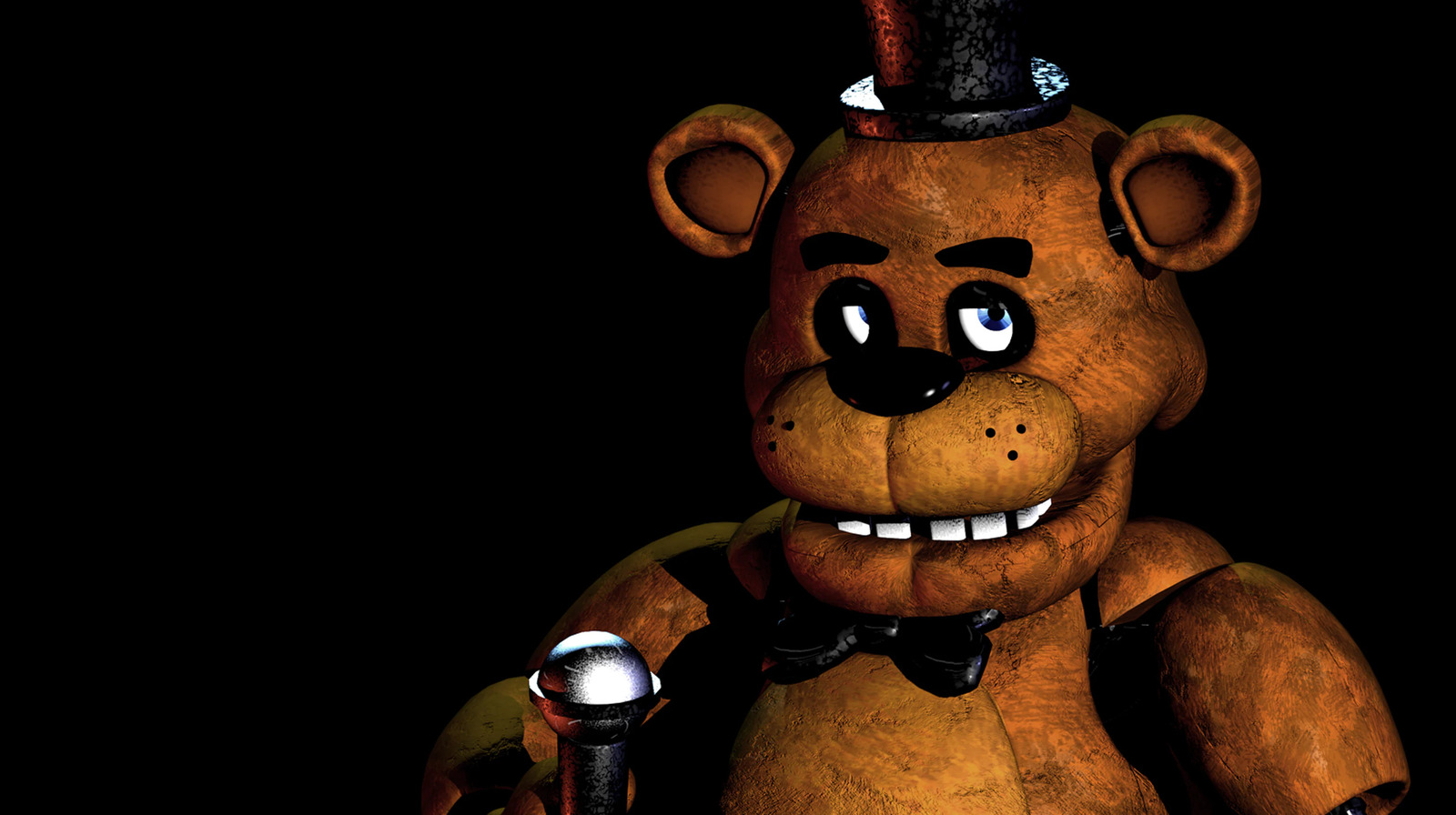
The Untold Truth Of The Five Nights At Freddy’s Movie – Looper
“Five Nights at Freddy’s” is a popular horror video game franchise originally created by indie developer Scott Cawthon. The first “FNAF” game was released for PC in 2014, and its massive success led to multiple sequels, spin-offs, and fan mods. There have also been a series of books set in the “FNAF” universe that expands on the franchise’s deep lore (to varying degrees of canonicity). After over a decade stuck in development hell, Blumhouse Productions will be releasing a big-budget feature film adaptation of “FNAF” in 2023, directed by Emma Tammi (“The Wind”) and starring Josh Hutcherson, Mary Stuart Masterson, and Matthew Lillard.
The first game was a first-person point-and-click horror game where the players take on the role of a down-on-their-luck security guard stuck looking at security monitors in the rundown Chuck E. Cheese-inspired “Freddy Fazbear’s Pizza.” During the first few nights, the player is given instructions by an unnamed predecessor who tells them about the dangers of the gig — namely that the creepy animatronics will walk around the closed restaurant at night, taking every opportunity to kill them. The player’s only course of action is to close the doors when they’re near, only they can’t keep the doors shut, otherwise they lose power and become defenseless.
Later sequels expanded greatly on this admittedly simple premise, including skipping around to different time periods, finding hidden mini-games that reveal story secrets, and creating an almost-Shakespearean familial drama that seemingly drives the whole plot.
Five Night’s at Freddy’s was inspired by a failed mobile game
 Scott Cawthon
Scott Cawthon
At this point, the indie video game series “Five Nights at Freddy’s” might be one of the most recognizable horror franchises in the world. While there are many things to praise about “FNAF” — such as its simple yet effective gameplay, creepy and dense lore, and perfectly timed jump scares — most of its success can be attributed to the great designs of the animatronic antagonists in the game, including the eponymous Freddy Fazbear.
However, it can also be attributed directly to Cawthon’s biggest initial failure. The frightening designs that have scared many players can be traced back to a cutesy game, where the characters’ off-putting and creepy visages were completely accidental.
That game was a free-to-play mobile game Cawthon designed called “Chipper & Sons Lumber Co.,” which was meant to be fun and kid-friendly, but the aforementioned character designs were criticized for being scary rather than endearing. Cawthon had been making wholesome Christian games prior to that, but the reception to “Chipper & Sons Lumber Co.” seems to be what caused him to pivot to horror games. While initially discouraged, the criticism of Cawthon’s “cute” character designs may have been a blessing in disguise, if merch sales and big-budget Hollywood film adaptations are anything to go by.
Film adaptation has been in development hell since 2015
 Universal Pictures
Universal Pictures
“Five Nights at Freddy’s” was pretty much a hit right out the gate when it came out, praised for its foreboding atmosphere, unique creature designs, and elegant and effective gameplay. While obviously frightening, the lack of actual gore — as well as some campily comedic touches, such as creator Scott Cawthon’s overwhelmed vocal performance as “Phone Guy” — allowed it to be safe enough for younger audiences, who are a big part of its fanbase.
Hollywood, of course, saw dollar signs and attempted to get to work on adapting it in earnest in 2015, just a year after the first game’s release. Gil Kenan, who had helmed the 2015 “Poltergeist” remake, was the first director attached, with Seth Grahame-Smith (“Abraham Lincoln: Vampire Hunter”) listed as a producer. Eventually, both Kenan and Grahame-Smith left the project due to the constant delays on Cawthon’s part.
Then, Blumhouse Productions bought the rights to the game and hired Chris Columbus (“Home Alone”) to write and direct, who was apparently a big fan of the game. However, he too eventually left the project after many re-writes and do-overs of the film’s script.
Finally, director Emma Tammi finally got the gig off the strength of her feature film debut, 2018’s “The Wind.”
Jim Henson Creature Shop is creating the animatronics
 Universal Pictures
Universal Pictures
A film adaptation of the “Five Nights at Freddy’s” video games will live or die by the quality of the film’s depictions of its monstrous animatronics. They have to look accurate to the games, while also being believable as the cute and cuddly mascots of the Chuck E. Cheese-esque Freddy Fazbear’s Pizza restaurant during its hey-day, and — most importantly — be legitimately scary during its horror sequences. That’s no easy task.
Luckily, the famous Jim Henson Creature Shop — named after the famed puppeteer himself — will be the ones responsible for creating Freddy Fazbear and his friends in the “Five Nights at Freddy’s” movie from Blumhouse.
The Jim Henson company, of course, should need no introduction, as they were the geniuses behind the creation of “The Muppets,” the puppet denizens of “Sesame Street,” the fantasy creatures in “Labyrinth,” and the ’90s “Teenage Mutant Ninja Turtles.” Kudos to Blumhouse for not going the CGI route with them, and hopefully, the rest of the film is as good as the character designs.
Five Nights at Freddy’s games jump back-and-forth in time
 Universal Pictures
Universal Pictures
“The Five Nights at Freddy’s” series, despite its humble beginnings, actually has a surprisingly epic and densely-packed lore that spans many decades. For instance, there is ample evidence that the first game is set in the mid-’90s. This includes the date on a check — Friday, November 12th – which even though there’s no year shown, narrows it down to 1993, due to that being the only time that day, month, and date all coincided during the games’ timeline. The minimum wage on the check — $4/hour — fits that era as well. This also means that the film could be a period piece as well.
“FNAF 2,” unlike the first game, is explicitly set in 1987. Furthermore, we see in the film trailer a screaming security guard — presumably “FNAF 2” protagonist Jeremy Fitzgerald — potentially depicting the infamous “bite of ’87” that is constantly being mentioned throughout the series.
Finally, in the film trailer, we see Matthew Lillard as William Afton and a possible shadow of his later postmortem form, Springtrap. If true, we could be seeing Afton as a human in the flashbacks and Springtrap throughout the rest of the film. This would also mean the film is merging game continuities since Springtrap doesn’t become a true antagonist until “FNAF 3.”
It’s speculated Michael Afton and Mike Schmidt are the same person
 Universal Pictures
Universal Pictures
In the first “Five Nights at Freddy’s” game, the down-on-his-luck security guard players control is named Mike Schmidt, who will be played in the film by Josh Hutcherson. At the end of the first game (assuming you don’t die in the interim), it is mentioned that Schmidt was fired for messing with the killer animatronics, and that’s supposedly the last we ever hear of him.
However, there’s a popular fan theory that many “FNAF” die-hards subscribe to, which states that Mike Schmidt and Michael Afton are the same people. Now who is Michael Afton? Well, in the games Michael Afton is the son of the deranged antagonist William Afton a.k.a Springtrap, and the protagonist of “FNAF: Sister Location,” where Michael Afton makes his first official appearance.
The evidence for this (beyond the fact that both characters are named “Mike”), seems to mostly stem from ancillary material. For instance, the activity book “Survival Logbook” — which is made to look like an instruction manual for “Freddy Fazbear Pizza” security guards — is said to have been owned by “Mike,” no last name. In the games, only Mike Schmidt is known to work at “Fazbear’s Pizza,” but the “Survival Logbook” also mentions events of the aforementioned “Sister Location” sequel, set thirty years later, that only Michael Afton would know.
Luckily, it seems like the movie might confirm — or debunk — this fan theory by the end.
Crying Child might be in the movie
 ScottGames
ScottGames
As in many popular horror franchises — including “It” and “The Exorcist” — death and tragedy befalling innocent children is a common plot point. In fact, despite the lack of much gore in “Five Nights at Freddy’s,” the gruesome story of murdered children getting their dead bodies (and later souls) stuffed into monstrous animatronics more than makes up for it. The child death count is surprisingly pretty high for a horror franchise that skews younger than most.
One such child victim that gets particular attention in the “FNAF” series is unnamed (outside of fan speculation), dubbed “The Crying Child.” He is the main character you play in “Five Nights at Freddy’s 4,” whose backstory is revealed through Atari-esque mini-games. According to lore, Crying Child was bullied by his older brother at a “Freddy Fazbear’s Pizza,” who was then bitten by an erratic Fazbear animatronic, eventually dying.
In a (since deleted) social media post, the actor playing “Young Mike” — Wyatt M. Parker — posted the words “Nice to see my little brother again!” on a picture of him with actor Lucas Grant. There are many fans who theorize that The Crying Child is Michael Afton’s little brother, and if Michael Schmidt and Afton are indeed the same people, that means that Mike accidentally killing his brother could also be the tragedy that makes him “riddled with guilt over a tragedy in his past,” as described in casting breakdowns via Geek Vibes Nation.
Vanessa is possibly main character of Five Nights at Freddy’s: Help Wanted
 ScottGames
ScottGames
Like a lot of horror game franchises, such as “Resident Evil” and “Silent Hill,” the various “Five Nights at Freddy’s” sequels usually follow different protagonists in each entry (albeit with some eventually returning). This means that while Mike Schmidt is the main character in the original “Five Nights at Freddy’s,” the other playable characters in the franchise include the ill-fated security guard Jeremy Fitzgerald in “Five Nights at Freddy’s 2,” and the Crying Child in “Five Nights at Freddy’s 4.”
Then in 2020, “Five Nights at Freddy’s: Help Wanted” was released, and it was eventually revealed that the game’s protagonist was the female security guard Vanessa. She then becomes the antagonist in 2021’s “Five Nights at Freddy’s: Security Breach,” having been corrupted by yet another incarnation of the evil William Afton. It’s rumored that the police officer Vanessa (Elizabeth Lail) is the same Vanessa from the games, especially since she “has a keen understanding of the dark history and inner workings of the restaurant (via Geek Vibes Nation).”
If true, it remains to be seen if she’ll share the same fate as the video game counterpart, or if they’ll do something different with the character since they are already changing her from a security guard to a police officer. It would also prove that the film will be merging continuities together, given that “Help Wanted” and “Security Breach” happened much later than the first game chronologically.
The first script involved the animatronics being secret government projects
 ScottGames
ScottGames
It’s no secret that Hollywood has been notoriously bad at adapting video games for some reason. From turning the live-action “Super Mario Bros.” film into a dystopian cyberpunk thriller, to whatever Uwe Boll thought he was doing in “House of the Dead,” video game movies have been rightly maligned for most of their existence. Only recently have they been getting regular commercial and critical success.
“Five Nights at Freddy’s” creator Scott Cawthon eventually discussed candidly on Reddit (or at least as candidly as he was legally allowed to) the lengthy production process and constant delays plaguing the highly-anticipated “FNAF” feature film adaptation. Cawthon also revealed the various script ideas that were pitched (then later rejected), before landing on the final script used as the basis for the Blumhouse version hitting theaters and streaming in 2023.
And, apparently, the first script written without Cawthon’s involvement was dubbed by him “The F Script.” Here’s the synopsis: “[a] group of teenage trouble-makers break into Freddy’s; chaos ensues.”
As Cawthon says, there’s no mention of any main characters from the games (i.e. standard “teens enter spooky place”) and it seems much too generic of a premise for a “FNAF” film. Furthermore, that means it would be yet another film adaptation of a video game to add unnecessary original protagonists to the story, like Alice in the “Resident Evil” films, or Cole Young from the 2021 “Mortal Kombat” reboot. Luckily, Cawthon passed on it.
Cawthon’s first attempts at writing the script himself were based on the books
 Scholastic, Inc.
Scholastic, Inc.
The popularity of the “Five Nights at Freddy’s” video games has helped it grow beyond the games themselves, from the upcoming movie to toys, clothes, and even a long-running book series.
For instance, there is “The Silver Eyes,” co-written by Kira Breed-Wrisley alongside “FNAF” creator Scott Cawthon, whose involvement gives the book some legitimacy. However, “The Silver Eyes” doesn’t follow the exact continuity of the games. It follows the character of Charlotte, who returns to her hometown years after a deadly tragedy involving the cursed Freddy Fazbear’s Pizza restaurant. Charlotte then meets up with her old friends, and they decide to visit Freddy Fazbear’s Pizza, which — in classic horror story fashion — leads to them all getting chased and almost killed by the possessed animatronics.
While “The Silver Eyes” was admittedly just an ancillary tie-in book, it was probably chosen by Cawthon as the spine of the possible film adaptation due to the fact that it already had characters with emotional arcs, clear motivations, and enough dialogue to adapt into a script. It seems, on paper, like it would be an easier translation to the big screen, especially considering the fact that the games have mostly silent protagonists that let the players become immersed in the world and horror themselves.
However, as this was Cawthon’s first attempt at screenwriting, the various early drafts weren’t very good, even by his own admission (via Reddit).
There were multiple drafts about ghost trackers
![]() Discovery+
Discovery+
Paranormal shows like “Ghost Hunters” and “Ghost Adventures” were a dime-a-dozen in the mid-00s due to their low production costs and easy-to-produce spectacle (it’s unsurprisingly really cheap to have people act scared about discovering standard electrical interference happening in electrical devices).
But this style was undeniably popular for a time, and it seems like this was the direction they were initially planning to take the “Five Nights at Freddy’s” movie. According to Cawthon, the story was about “[a] group of amateur ghost-trackers [who] sneak into the abandoned Freddy’s.”
Like the first attempt at adapting “FNAF” into a film — the ill-fated “F Script” — the “ghost tracker” version of the story focused on original characters instead of figures from the games. To be fair, it does seem like there was some sort of logic to this version, but it ultimately strayed too much from the game’s lore. Cawthon agreed, stating: “though a very common-sense setup for this sort of movie … What ended up happening was too much of the story went to their own backstories and their own hardships, and it took the spotlight away from the story of Freddy’s.”
There was a plushies take Manhattan version of the film’s script
 ScottGames
ScottGames
Another script treatment that was pitched before “Five Nights at Freddy’s” creator Scott Cawthon got officially involved, was described by the creator on Reddit simply as the “‘plushies take Manhattan’ version.”
Not much is known about this take, as according to Cawthon the plot was also just “plushies take Manhattan.” Furthermore, Cawthon seemed very displeased with it, stating the problem with this version was “plushies take Manhattan.” It was then “burned with fire.”
If we had to guess, it seems like it would have a “monsters on rampage in the city”-type movie, and probably wouldn’t have the same claustrophobic feel of the games, which is a great part of its appeal. Large walking animatronics would be admittedly scary and off-putting in any situation, to be sure; however, in a city situation, it’s much easier to find ways to run away and escape from the lumbering robots. Being trapped in a rundown pizzeria — or a children’s bedroom — makes escape much more harrowing and difficult. Also, this type of narrative speaks to a different type of horror than what “FNAF” is known for, as Freddy Fazbear and his friends are mostly creepy rather than being outright violent monsters going out of their way to kill people left and right. All things considered, the death count in “FNAF” is relatively low. In fact, in most canonical endings, the protagonists are usually fired rather than killed anyway.














































































